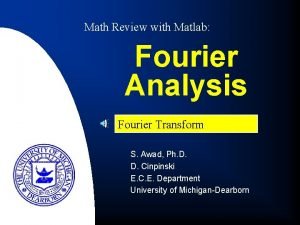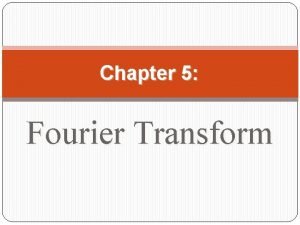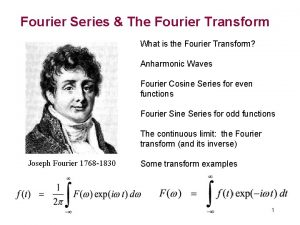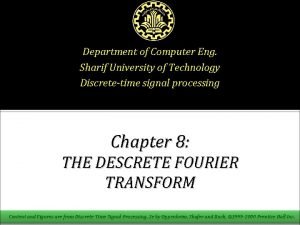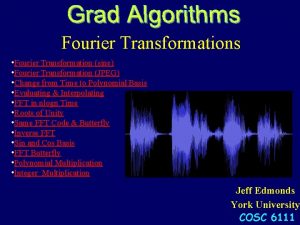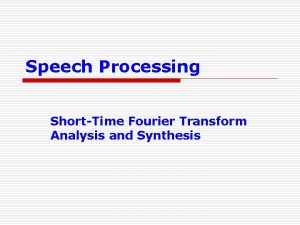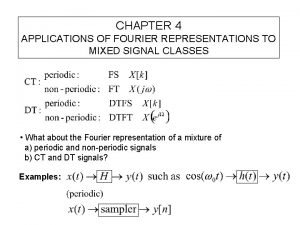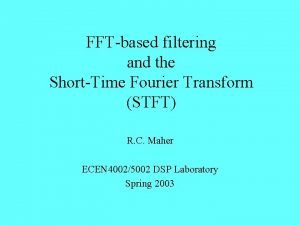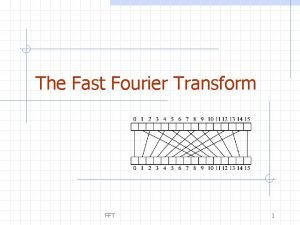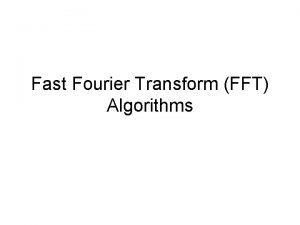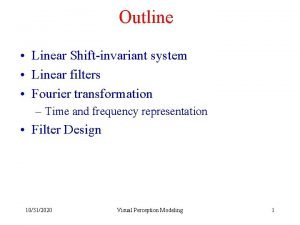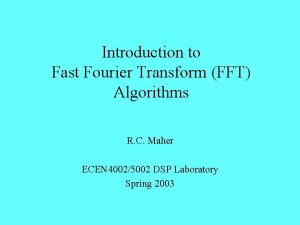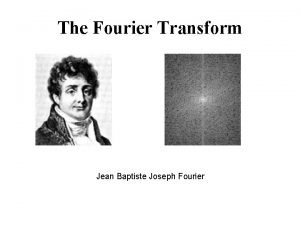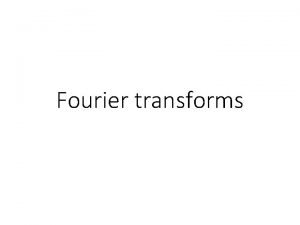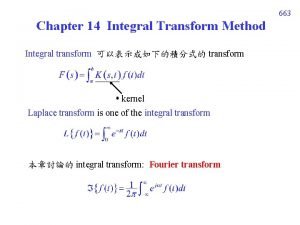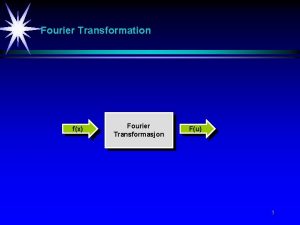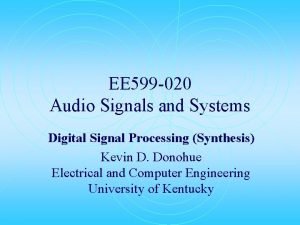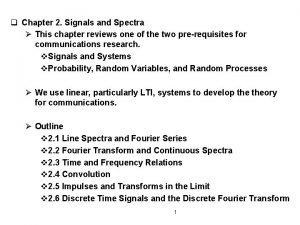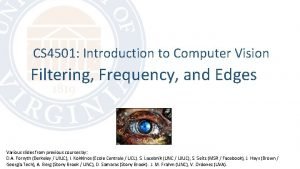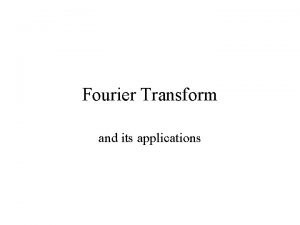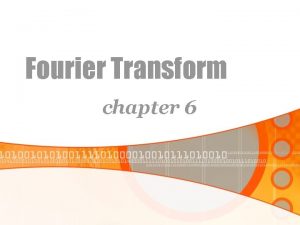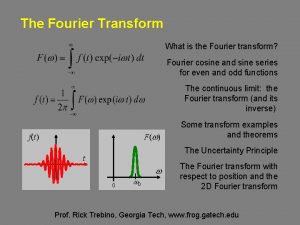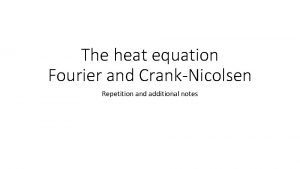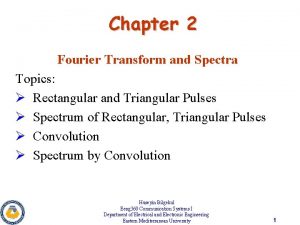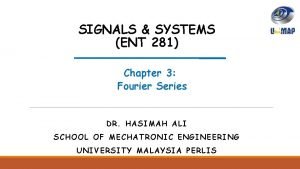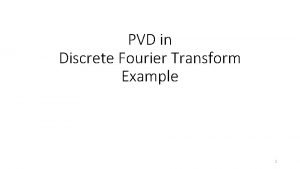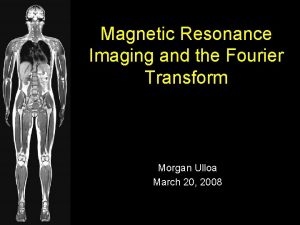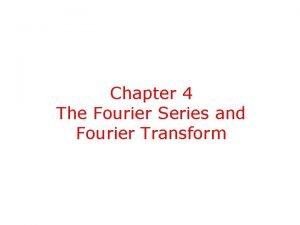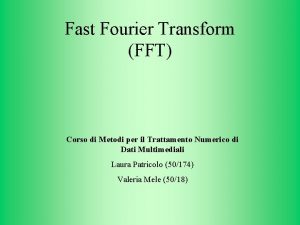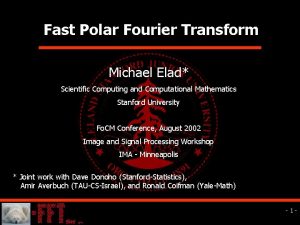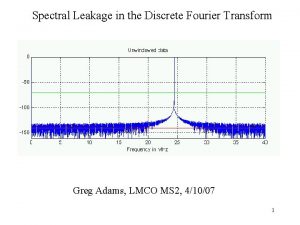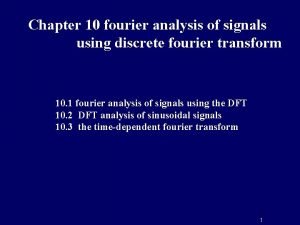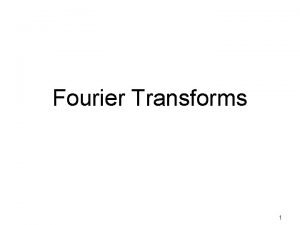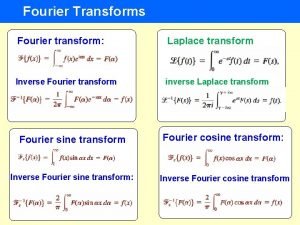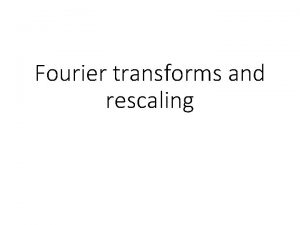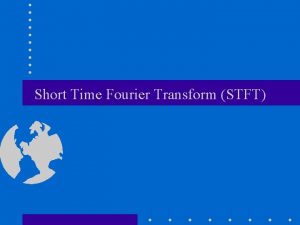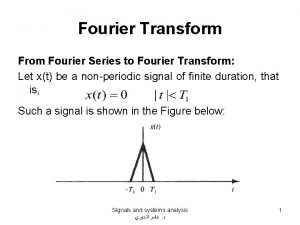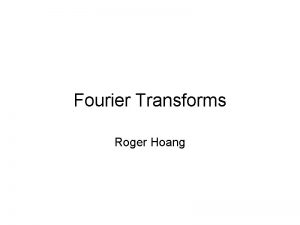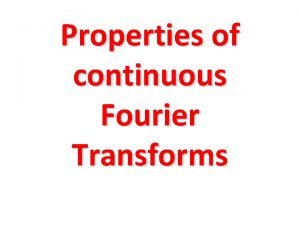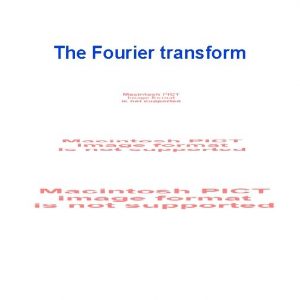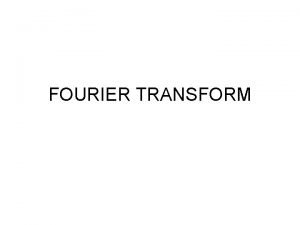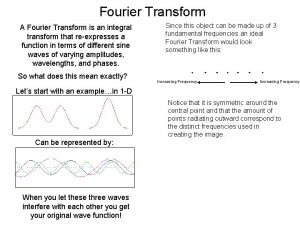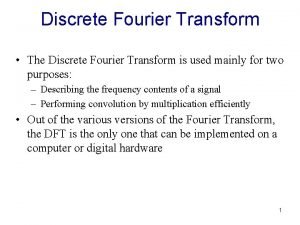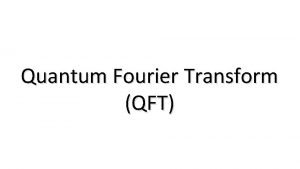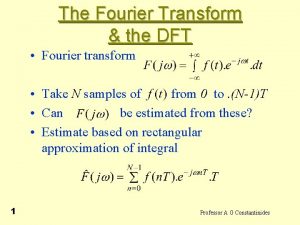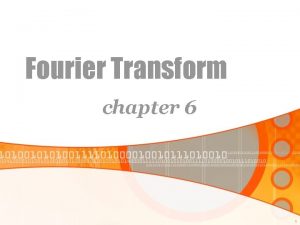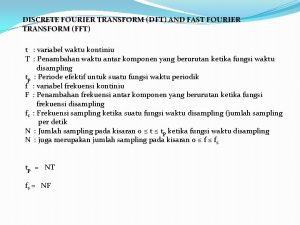Fourier Transforms Fourier transform for 1 D images


































- Slides: 34

Fourier Transforms

Fourier transform for 1 D images •

Fourier transform for 1 D images •

Fourier transform •

Visualizing the Fourier basis for 1 D images

Signal cos impulse Fourier transform impulse cos

Fourier transform for images •

Visualizing the Fourier basis for images

Visualizing the Fourier transform • Given Nx. N image, there are Nx. N basis elements • Fourier coefficients can be represented as an Nx. N image

Converting to and from the Fourier basis •

Why Fourier transforms? • Think of image in terms of low and high frequency information • Low frequency: large scale structure, no details • High frequency: fine structure

Why Fourier transforms?

Why Fourier transforms?

Why Fourier transforms? Removing high frequency components looks like blurring. Is there more to this relationship?

Dual domains • Image: Spatial domain • Fourier Transform: Frequency domain • Amplitudes are called spectrum • For any transformations we do in spatial domain, there are corresponding transformations we can do in the frequency domain • And vice-versa Spatial Domain

Dual domains • Convolution in spatial domain = Point-wise multiplication in frequency domain • Convolution in frequency domain = Point-wise multiplication in spatial domain

Signal cos impulse Fourier transform impulse cos

Signal box “sinc” = sin(x)/x Fourier transform “sinc” = sin(x)/x box

Signal Gaussian Fourier transform Gaussian

Signal Gaussian Fourier transform Gaussian

Image Fourier transform

Image Fourier transform

Detour: Time complexity of convolution • Image is w x h • Filter is k x k • Every entry takes O(k 2) operations • Number of output entries: • (w+k-1)(h+k-1) for full • wh for same • Total time complexity: • O(whk 2)

Optimization: separable filters • basic alg. is O(r 2): large filters get expensive fast! • definition: w(x, y) is separable if it can be written as: • Write u as a k x 1 filter, and v as a 1 x k filter • Claim:

Separable filters u 1 u 2 * v 1 v 2 v 3 u 1 u 3 u 2 u 3 u 1 v 1

Separable filters u 1 u 2 * v 1 v 2 v 3 u 1 u 3 u 2 u 3 u 1 v 1 u 1 v 2

Separable filters u 1 u 2 * v 1 v 2 v 3 u 1 u 3 u 2 u 3 u 1 v 1 u 1 v 2 u 1 v 3

Separable filters u 1 u 2 * v 1 v 2 v 3 u 1 u 3 u 1 v 1 u 2 u 2 v 1 u 3 u 1 v 2 u 1 v 3

Separable filters u 1 u 2 * v 1 v 2 v 3 u 1 u 3 u 1 v 1 u 1 v 2 u 2 u 2 v 1 u 2 v 2 u 3 u 1 v 3

Separable filters u 1 u 2 * v 1 v 2 v 3 u 1 u 3 u 1 v 1 u 1 v 2 u 1 v 3 u 2 u 2 v 1 u 2 v 2 u 2 v 3 u 1

Separable filters u 1 u 2 * v 1 v 2 v 3 u 1 u 3 u 1 v 1 u 1 v 2 u 1 v 3 u 2 u 2 v 1 u 2 v 2 u 2 v 3 u 1 u 3 v 1

Separable filters u 1 u 2 * v 1 v 2 v 3 u 1 u 3 u 1 v 1 u 1 v 2 u 1 v 3 u 2 u 2 v 1 u 2 v 2 u 2 v 3 u 1 u 3 v 2

Separable filters u 1 u 2 * v 1 v 2 v 3 w u 3 u 1 v 1 u 1 v 2 u 1 v 3 u 2 u 2 v 1 u 2 v 2 u 2 v 3 u 1 u 3 v 2 u 3 v 3

Separable filters • Time complexity of original : O(whk 2) • Time complexity of separable version : O(whk)
 Fourier transform of ramp function
Fourier transform of ramp function Fourier transform definition
Fourier transform definition Series de fourier
Series de fourier Fourier transform of impulse train
Fourier transform of impulse train Jpeg fourier transform
Jpeg fourier transform Short time fourier transform applications
Short time fourier transform applications Inverse dtfs
Inverse dtfs Stft
Stft Fourier transform
Fourier transform Java fast fourier transform
Java fast fourier transform Dft vs fft
Dft vs fft Sinc function fourier transform
Sinc function fourier transform Introduction to fast fourier transform
Introduction to fast fourier transform Even fourier
Even fourier Fourier cosine transform of f(x)=1
Fourier cosine transform of f(x)=1 Fourier transform of gaussian filter
Fourier transform of gaussian filter Fourier transform pair
Fourier transform pair Fourier transform
Fourier transform Sinc fourier transform
Sinc fourier transform Line spectrum in signals and systems
Line spectrum in signals and systems Inverse of fourier transform
Inverse of fourier transform The fourier transform and its applications
The fourier transform and its applications Transformata laplace calculator
Transformata laplace calculator Define inverse fourier transform
Define inverse fourier transform Heat equation
Heat equation Fourier transform of shifted rectangular pulse
Fourier transform of shifted rectangular pulse Convert trigonometric fourier series to exponential
Convert trigonometric fourier series to exponential Fourier transform
Fourier transform Fourier transform mri
Fourier transform mri Fourier transform formula
Fourier transform formula Fft butterfly
Fft butterfly Polar fourier series
Polar fourier series Fourier series
Fourier series Nstemk
Nstemk Fourier transformation equation
Fourier transformation equation
